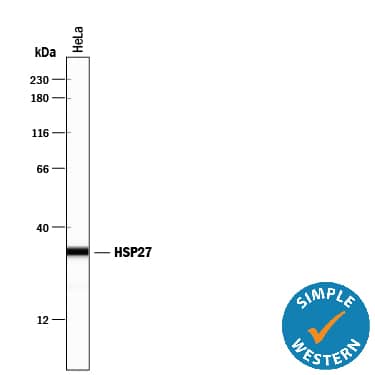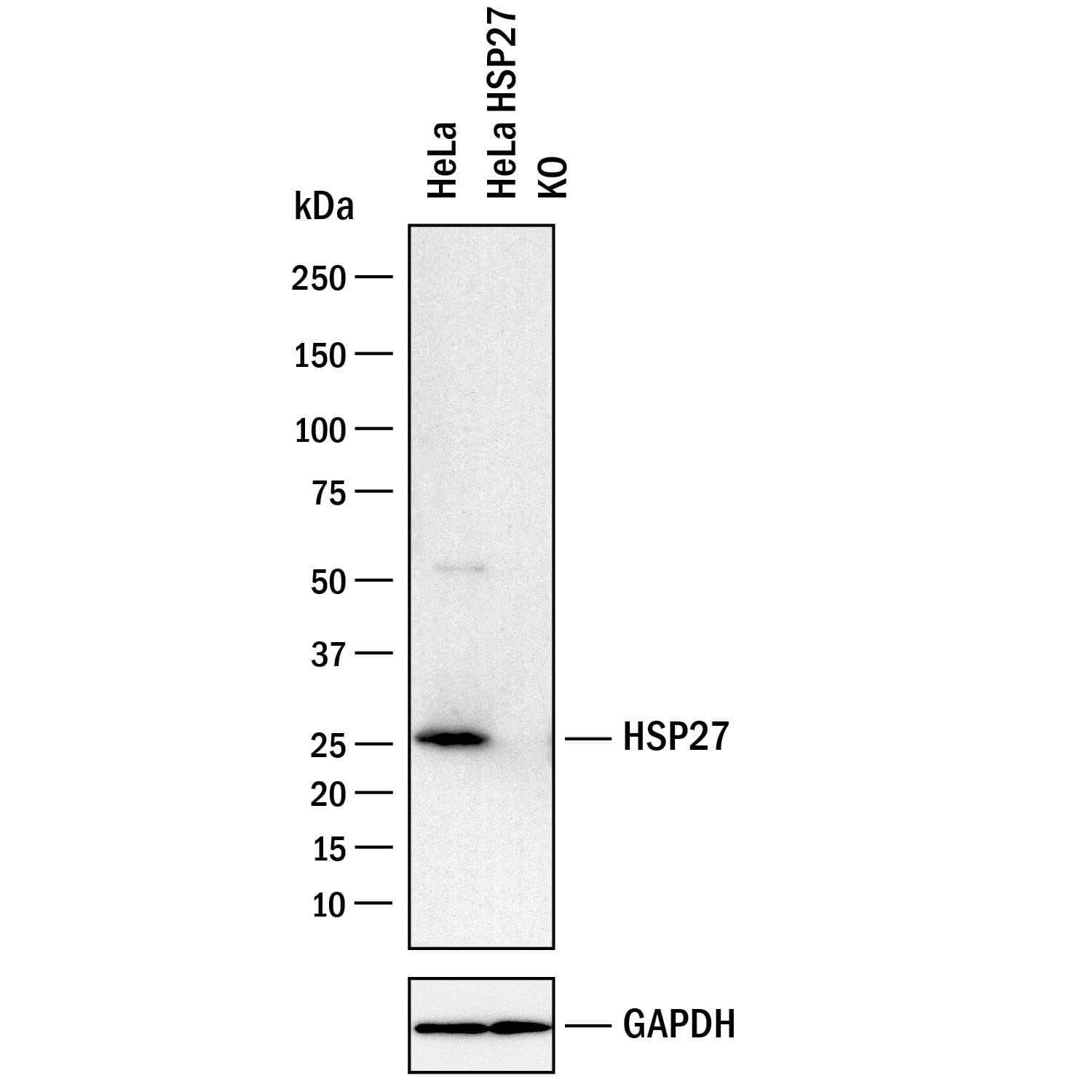Human HSP27 Antibody
R&D Systems, part of Bio-Techne | Catalog # AF1580

Key Product Details
Validated by
Knockout/Knockdown
Species Reactivity
Validated:
Human
Cited:
Human, Mouse
Applications
Validated:
Knockout Validated, Western Blot, Simple Western
Cited:
Western Blot, Flow Cytometry, Simple Western
Label
Unconjugated
Antibody Source
Polyclonal Rabbit IgG
Product Specifications
Immunogen
E. coli-derived recombinant human HSP27
Accession # P04792
Accession # P04792
Specificity
Detects recombinant and endogenous human HSP27 in Western blots.
Clonality
Polyclonal
Host
Rabbit
Isotype
IgG
Scientific Data Images for Human HSP27 Antibody
Detection of Human HSP27 by Western Blot.
Western Blot shows lysates of HeLa human cervical epithelial carcinoma cell line and DU145 human prostate carcinoma cell line. PVDF membrane was probed with 0.1 µg/ml of Rabbit Anti-Human HSP27 Antigen Affinity-purified Polyclonal Antibody (Catalog # AF1580) followed by HRP-conjugated Anti-Rabbit IgG Secondary Antibody (Catalog # HAF008). A specific band was detected for HSP27 at approximately 27 kDa (as indicated). This experiment was conducted under reducing conditions and using Western Blot Buffer Group 1.Detection of Human HSP27 by Simple WesternTM.
Simple Western lane view shows lysates of HeLa human cervical epithelial carcinoma cell line, loaded at 0.2 mg/mL. A specific band was detected for HSP27 at approximately 31 kDa (as indicated) using 0.5 µg/mL of Rabbit Anti-Human HSP27 Antigen Affinity-purified Polyclonal Antibody (Catalog # AF1580). This experiment was conducted under reducing conditions and using the 12-230 kDa separation system.Western Blot Shows Human HSP27 Specificity by Using Knockout Cell Line.
Western blot shows lysates of HeLa human cervical epithelial carcinoma parental cell line and HSP27 knockout HeLa cell line (KO). PVDF membrane was probed with 0.5 µg/mL of Rabbit Anti-Human HSP27 Antigen Affinity-purified Polyclonal Antibody (Catalog # AF1580) followed by HRP-conjugated Anti-Rabbit IgG Secondary Antibody (HAF008). A specific band was detected for HSP27 at approximately 27 kDa (as indicated) in the parental HeLa cell line, but is not detectable in knockout HeLa cell line. GAPDH (MAB5718) is shown as a loading control. This experiment was conducted under reducing conditions and using Immunoblot Buffer Group 1.Applications for Human HSP27 Antibody
Application
Recommended Usage
Knockout Validated
HSP27 is specifically detected in HeLa human
cervical epithelial carcinoma parental cell line but is not detectable in
HSP27 knockout HeLa cell line.
Simple Western
0.5 µg/mL
Sample: HeLa human cervical epithelial carcinoma cell line
Sample: HeLa human cervical epithelial carcinoma cell line
Western Blot
0.1 µg/mL
Sample: HeLa human cervical epithelial carcinoma cell line and DU145 human prostate carcinoma cell line
Sample: HeLa human cervical epithelial carcinoma cell line and DU145 human prostate carcinoma cell line
Formulation, Preparation, and Storage
Purification
Antigen Affinity-purified
Reconstitution
Reconstitute at 0.2 mg/mL in sterile PBS. For liquid material, refer to CoA for concentration.
Formulation
Lyophilized from a 0.2 μm filtered solution in PBS with Trehalose. See Certificate of Analysis for details.
*Small pack size (-SP) is supplied either lyophilized or as a 0.2 µm filtered solution in PBS.
*Small pack size (-SP) is supplied either lyophilized or as a 0.2 µm filtered solution in PBS.
Shipping
Lyophilized product is shipped at ambient temperature. Liquid small pack size (-SP) is shipped with polar packs. Upon receipt, store immediately at the temperature recommended below.
Stability & Storage
Use a manual defrost freezer and avoid repeated freeze-thaw cycles.
- 12 months from date of receipt, -20 to -70 °C as supplied.
- 1 month, 2 to 8 °C under sterile conditions after reconstitution.
- 6 months, -20 to -70 °C under sterile conditions after reconstitution.
Background: HSP27
References
- Gusev, N.B. et al. (2002) Biochemistry (Moscow) 67:511.
- Garrido, C. et al. (2001) Biochem. Biophys. Res. Commun. 286:433.
- Garrido, C. (2002) Cell Death Diffr. 9:483.
- Brvey, J-M. et al. (2000) Nat. Cell Biol. 2:645.
Long Name
Heat Shock Protein 27
Alternate Names
HSP25, HSPB1
Gene Symbol
HSPB1
UniProt
Additional HSP27 Products
Product Documents for Human HSP27 Antibody
Product Specific Notices for Human HSP27 Antibody
For research use only
